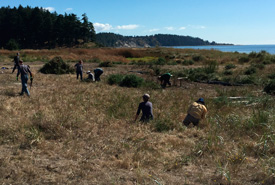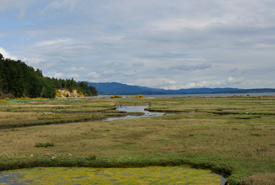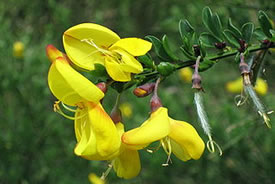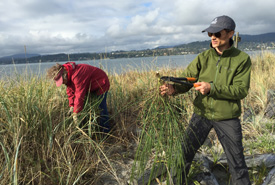Restoring the dunes of James Island, BC

Volunteers at the Broom Bash event on James Island, BC (Photo by Ann MacDonald)
“Covenant,” from the French word "convenir," means to come together. And this fall, 11 of us did just that as Conservation Volunteers with the Nature Conservancy of Canada (NCC). We spent a sunbaked autumn day yanking gorse and Scotch broom on the northwest coast of James Island, British Columbia on a conservation agreement (also known as a conservation covenant) held by NCC on parts of the island.
At its highest point, James Island is about 58 metres above sea level, but we spent the day at less than two metres, surrounded on all three sides by the Pacific Ocean. A gentle breeze moved through the grass all day. Waves lapped around us, easily quelling the hustle and bustle of Vancouver Island, just one kilometre in the distance.

James Island, BC (Photo by NCC)
The island is within the traditional territory of the Tsawout First Nation; one of its hereditary chiefs was born here in 1860. Prior to being privately purchased, James Island served as a private hunting ground for Victoria’s sportsmen at the turn of the last century, and then became the site of a dynamite plant that operated well into the Second World War. By 1988, the village and factories had been removed and the site remediated.
James Island is located in Haro Strait, at the southern end of BC’s Gulf Island chain. While it is about 778 acres (315 hectares) in total, the NCC conservation agreement applies to about 20 per cent of the island; almost 155 acres (63 hectares). Chosen initially as a munitions factory for its remote and defendable position, it seems an ironic twist of ecological fate that the removal of this same activity in fact led to conditions favourable to its actual invasion by the ever-pervasive broom and gorse, likely during the time the work was done to remediate the soil.

Scotch broom (Photo by Wikimedia Commons)
Today, the northern spit of the island includes a freshwater wetland and sparse vegetation, with patches of dune grass, big-head sedge and yellow sand verbena. Verbena is a small herb that features showy heads of bright yellow flowers. It is only found in coastal dune areas of BC.
Back at the event, we arrived by ferry and were dispatched into teams of two. One person carried a pair of brightly coloured loppers that fearless trip leader, Todd Carnahan, guaranteed would chop through any stem as long as you can get the blades around it. The other person’s role was to first ferret out the tap sprout of the vicious and invasive little species known as Scotch broom, then cut, yank and pull out the plant. By removing the invasive plants, the volunteers made room for indigenous plants such as dune grass and verbena to take root and thrive.

Todd Carnahan demonstrates how to remove Scotch broom (Photo by Ann MacDonald)
We moved quickly, piling the removed plants on landscape fabric in order to prevent the spread of broom and gorse toxins into the sand. We took great comfort in the size of these growing piles, despite knowing full well that the roots of the plants, some growing as much as 15 feet deep, were still safely ensconced on the spit.
We enjoyed lunch together on the sheltered south side of the spit, sharing stories and tales of other such volunteer pursuits. Most of the group had engaged in a wide range of similar conservation activities with NCC and other organizations. For anyone who might have spotted us from the air that day, perched as we were eating lunch in the sun on driftwood and rocks amidst the gentle roll of the waves, they could not have missed how formidable a team we were.
We were visited by one pesky wasp, a mew gull and a northern harrier. Having already been stung once that day, I was too busy entertaining the wasp to actually see the harrier land.
Nourished by Todd’s endless supply of bananas and chocolate and juicy little tomatoes, we had a great day, and came away satisfied by a job well done. Sign me up for next year!


